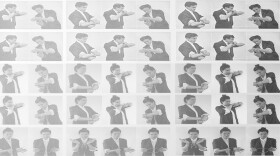Artist John Mulvany hasn’t had a solo show of paintings in quite a while, largely because his life started getting a little busier lately.
“I had kids in the last few years, and they’ve taken a lot of time [and] energy and art kind of went on the back burner for a little bit,” he says. “But during that time I was doing a lot of walking around my neighborhood in East Austin, just noticing a lot of things that I hadn’t before. And the show sort of evolved from there.”
The genesis of his new show, Secure the Perimeter, was in those neighborhood walks. Mulvany decided to create “an exhibition of work about the neighborhood, or using the neighborhood as an allegory for what’s happening in the country and the world,” he says. “And the idea of it being about life cycles, and that the neighborhood itself is in a constant state of creation and transformation and decay, and that’s kind of where we are in our politics and in the world in general.
“Everything that’s in the show is … something that I directly experienced or saw, but I sort of filtered it out to think about how that might relate to something else that was happening in the background,” Mulvany says. “Like after the 2016 election, it was this feeling, I think … of 'What is the country’s identity now?’ So I felt like I really wanted to engage with that but in a way that wasn’t really direct, or wasn’t just propaganda images.”
Mulvany says he started to view the works differently after some life-altering events. “I’d been working on it for about three months, and then … I had to go back to Ireland – I’m originally from Ireland – for a couple of months in the middle of it because my mother was dying,” he says. “And then when I came back, looking at the work again… it just looked different. New layers of meaning crept out of it, or emerged from it. So I kind of engaged with that a bit more as well, to think a bit more about life cycles and the passing of time and changes and all of those things.”
Seeing his own art through different eyes made Mulvany think about the ways different audiences might view the work. “Me having that experience as an artist, seeing it fresh in that way, sort of made me conscious of wanting to make it open enough for people to interpret it in their own way.”
Once the new works were completed, gallery owner Jill Schroeder worked with Mulvany to arrange the show at grayDUCK Gallery, and Mulvany found that he was seeing the paintings differently again. “It looks really different to how it looked in my studio,” he says with a laugh. “Just seeing it arranged differently made me see it again in a different way. I was very open to that. You know, I kind of like that collaborative nature of somebody else looking at your work and engaging with it objectively. I like that about an audience, too.”





